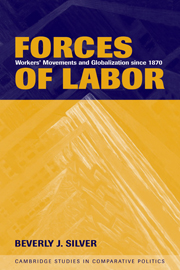Book contents
- Frontmatter
- Contents
- List of Figures
- List of Tables
- Preface and Acknowledgments
- 1 INTRODUCTION
- 2 LABOR MOVEMENTS AND CAPITAL MOBILITY
- 3 LABOR MOVEMENTS AND PRODUCT CYCLES
- 4 LABOR MOVEMENTS AND WORLD POLITICS
- 5 CONTEMPORARY DYNAMICS IN WORLD-HISTORICAL PERSPECTIVE
- Appendix A The World Labor Group Database: Conceptualization, Measurement, and Data Collection Procedures
- Appendix B Instructions for Recording Data from Indexes
- Appendix C Country Classifications
- References
- Index
- Cambridge Studies in Comparative Politics
Appendix A - The World Labor Group Database: Conceptualization, Measurement, and Data Collection Procedures
Published online by Cambridge University Press: 05 June 2012
- Frontmatter
- Contents
- List of Figures
- List of Tables
- Preface and Acknowledgments
- 1 INTRODUCTION
- 2 LABOR MOVEMENTS AND CAPITAL MOBILITY
- 3 LABOR MOVEMENTS AND PRODUCT CYCLES
- 4 LABOR MOVEMENTS AND WORLD POLITICS
- 5 CONTEMPORARY DYNAMICS IN WORLD-HISTORICAL PERSPECTIVE
- Appendix A The World Labor Group Database: Conceptualization, Measurement, and Data Collection Procedures
- Appendix B Instructions for Recording Data from Indexes
- Appendix C Country Classifications
- References
- Index
- Cambridge Studies in Comparative Politics
Summary
The World Labor Group (WLG) database is one of the key empirical sources used in this book to document world-historical patterns of labor unrest. This database originates in a collective research effort by a group of graduate students and faculty (The World Labor Research Working Group) at the Fernand Braudel Center (Binghamton University) in the 1980s. The outcome of the group's work was published as a special issue of Review – hereafter referred to as “the special issue” (see Silver, Arrighi, and Dubofsky 1995). The present author subsequently expanded and updated the database produced in the first phase of the project.
This appendix describes the WLG data collection project including issues of conceptualization, measurement, and data collection procedures (see Silver 1995a in the special issue for a more in-depth treatment of these issues). The next section discusses the conceptualization of labor unrest used by the World Labor Group (see also Chapter 1). The second section discusses measurement issues, the third section discusses data collection procedures, and the fourth section discusses the outcome of various reliability studies. Finally, Appendix B reproduces the data collection instructions used for compiling the WLG database.
The Concept of World-Scale Labor Unrest
Efforts to gain an adequate picture of the long-term, world-scale patterns of labor unrest face special problems of conceptualization and measurement. Workers' resistance has taken a variety of forms over the space and time of the world economy. While it might at first seem intuitively obvious, the concept of labor unrest as a world-historical phenomenon and how one might go about measuring it are far from obvious.
- Type
- Chapter
- Information
- Forces of LaborWorkers' Movements and Globalization Since 1870, pp. 181 - 197Publisher: Cambridge University PressPrint publication year: 2003



